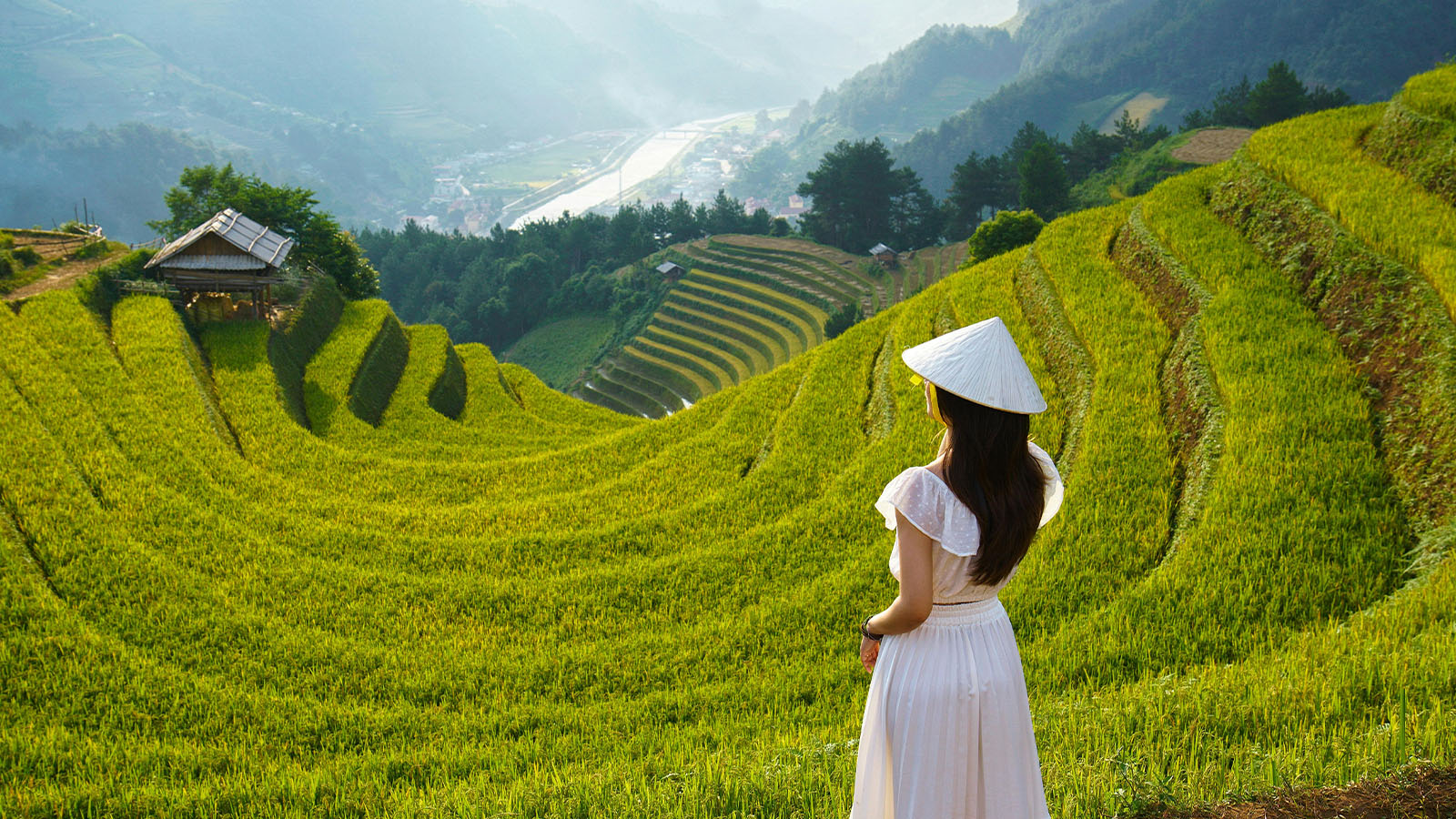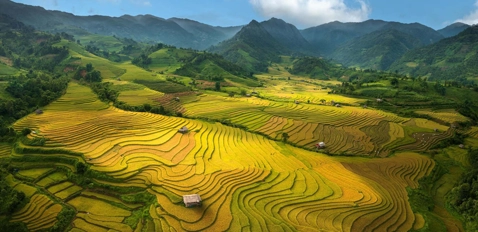Top 10 Best Things to Do in Hanoi Old Quarter
With a rich history, culture and cuisine, Hanoi has a contemplative and unique beauty, ancient mixed with modernity, which makes Hanoi an alluring tourist destination that anyone lingers in even once. Here are some suggestions for the top 10 best things to do in Hanoi, which are the must-see attractions in Hanoi, Capital of thousand years of civilization.
The President Ho Chi Minh Mausoleum
Once setting foot in Hanoi, Vietnam's oldest capital city, tourists cannot possibly ignore one of the most historic tourist attractions, the Ho Chi Minh Mausoleum, located in Ba Dinh Square in Central Hanoi. This destination is extremely renowned for the magnificent historical values of Vietnamese people. Ho Chi Minh is the beloved Great Father of the Vietnamese, who brought Vietnam to Independence and now has been the symbol of Vietnam’s unification and liberation. Reaching there, not only tourists can express their gratefulness and sincere gratitude to Uncle Ho an discover more about his private life, bu foreign visitors also broaden their knowledge about Vietnam’s history through thousands of years of colonization and invasion.
Vietnam Museum of Ethnology
Another fabulous tourist destination for history lovers is the Vietnam Museum of Ethnology, which the Vietnamese Government constructed to preserve and present the valuable cultural heritages of 54 ethnic groups. Starting the construction in 1987 and completing it after 10 years, the Museum is established with the purpose of accumulating, displaying, researching and preserving the precious historical and cultural inheritance of the nation’s ethnic minorities, such as various exhibits and beautiful artifacts. With divergent and colorful culture and traditions, the Vietnam Ethnology Museum is an absolutely perfect choice for exploring the diverse culture and broadening horizons on Vietnamese ethnic communities. Once contemplating the vivid and lively pictures of the peaceful daily life of these ethnic groups, perhaps no foreign tourist will be able to refuse to visit the Vietnam Museum of Ethnology.
Hoan Kiem Lake
Hoan Kiem Lake (Guom Lake) is a favorite tourist destination and iconic landscape for both domestic and foreign visitors, as it is the perfect rendezvous all year round with pleasant and gorgeous natural scenery. Located in the central area of the thousand-year city, Hoan Kiem Lake is regarded as the heart and also the historical and cultural symbol of the Capital of thousand years of civilization. In the center of Hoan Kiem Lake, Thap Rua (Turtle Tower) was built from 1884 to 1886 on the Turtle Mound with a great combination of two different architectural styles, French and local architecture, which creates the unique and charming beauty of Turtle Tower. Around the Tower are a variety of renowned heritages, such as Ngoc Son Temple, The Huc Bridge leading to Dac Nguyet Floor, Dai Nghien and Thap But (Pen Tower). Thanks to the fresh atmosphere and cool space, Hoan Kiem Lake becomes the popular place for young couples to make a date, hold important events, take wedding photos, or simply go sightseeing for relaxation.
Long Bien Bridge
Long Bien Bridge is another destination that can’t be missed when travelling to Ha Noi. Its original name was Paul Doumer Bridge, and it crosses the Red River. Long Bien Bridge is one of the most famous historical bridges in Vietnam since this bridge was designed and constructed with harmonious and impressive architecture by the French company Daydé & Pillé in 1903. Seen from afar, Long Bien Bridge looks like an enormous dragon that is imposing, brave and strong, standing in the giant Red River. Long Bien Bridge is a pivotal historic witness that has observed multiple significant milestones through Vietnamese history, from the French colonialists to the US imperialists and the present independence of the Vietnamese nation.
Van Phuc Silk Village
During the stay in Hanoi, visitors can not miss the trip to visit the traditional silk-making industry in Van Phuc Silk Village, which is extremely well known as the most ancient silk village. Located on the bank of the Nhue River, exactly 8 kilometers southwest of Hanoi Old Quarter, the village has been producing a variety of traditional silk products, which used to be regarded as very precious handwork to make dresses for royal members in the past. Up to now, the luxurious, sumptuous and unique beauty of Van Phuc silk is an endless source of inspiration in the great number of Vietnamese poems, movies, plays and songs. Especially, foreign visitors coming here will be certainly lured by various high-quality silk products such as ties, dresses, shirts, and crafts. Nowadays, Van Phuc Silk Village has been a special tourist attraction to exchange unique historical and cultural values through typical handicraft products and the village simultaneously becomes a commercial place that draws both domestic and foreign tourists to purchase silk products and buy them as a gift or souvenir with a reasonable price and outstanding quality.
Hanoi Opera House
Wandering around the thousand-year city, it is impossible to not mention the Hanoi Opera House, which is a stunning, appealing and charming colonial architectural artwork in the heart of the capital. Hanoi Opera House was constructed by the French colonial authority during their time in Indochina, and its construction took place for 10 years, from 1901 to 1911. The idea for the erection was taken inspiration from Paris’s Opera House and classical Greek Architecture, which makes the Hanoi Opera House one of the most outstanding, unique, specific and artistic buildings in the Asian area. With an area of 2600 square meters and a height of 34 meters, it is like a masterpiece of neoclassical French architectural work, perfectly depicting Gothic themes with shuttered windows, a classic roof, tall pillars, and balconies. In the past, Hanoi opera House was a luxurious and academic art place where art performances of ballets, musicals, and concerts were organized for the French administration to enjoy and entertain and, at the same time, to spread French culture to Vietnamese. After 1945, Hanoi Opera House became an important place for holding integral historical and political events and the formal meeting place of the National Assembly, the Government and military parades. Up to now, visitors can come to contemplate music, from classical types to traditional artwork and folk music of the Vietnamese people. It can be said that the Hanoi Opera house witnessed Vietnam’s initial approach to Western art and brings the paramount importance of the historical, cultural, political, architectural and artistic worth. For those who enjoy exchanging cultural activities, contemplate musical art and admire the sophisticated architectural landmark designed in French style, the Hanoi Opera House is certainly the most wonderful tourist destination.
St Joseph’s Cathedral, Hanoi
Another stunning artwork from French colonists is St. Joseph’s Cathedral Hanoi or Hanoi Cathedral. The architecture has lasted more than one hundred years, from 1884 to 1887 and it is the first building erected by the French colonial administration in Indochina. The architecture of Hanoi Cathedral is so special and ancient, as the building style was based on the model of Medieval Gothic architecture but there was a great combination of Eastern and Western architectural features. With a length of 64.5 meters and a width of 20.5 meters, the structure contains two square bell towers (31.5 meters in height) and a big clock in the middle and looks like Notre Dame de Paris. There is a big statue of Mother Maria made of copper and flowers, trees and iron fences are decorated surroundings. From the exterior side, the wall brings an ancient beauty of historical marks through ups and downs during hundreds years. However, the interior design is decorated in Vietnamese style and very modern architecture, with two main typical colors, yellow and red, which makes the inside a sparkling, brilliant atmosphere with domes, gold-plated wooden patterns and doorways. Hanoi Cathedral is the most charming tourist attraction for not only the local and foreign Catholics but also for all visitors as a whole to explore the ancient beauty and the remarkable architectural style of the oldest church in the center of the bustling capital.
Temple of Literature—The First University in Vietnam
For those who are fond of studying, the Temple of Literature cannot be missed. It is the longest-lasting Imperial Academy and the first National University of Vietnam. The temple characterizes Vietnamese antique architectural style and traditional high affection for studying. Firstly constructed in 1070 in the Ly dynasty and reconstructed many times during 1225–1400 in the Tran Kings, the Temple of Literature went through centuries of historical changes, conflicts and colonization, fierce wars, severe disasters, and many restorations. With the entire campus of 54,331 square meters, the structure of the Temple of Literature is divided into two areas, the Exterior (Lake of Literature & Giam Garden) and the Interior Area, which contains five different sections. Lake of Literature is to worship Confucius and the influential Confucians, while Giam Garden is the place to venerate the teacher, Chu Van An, a virtuous man who made significant contributions to Vietnam’s national education. The atmosphere inside is still quiet, solemn and peaceful. Up to now, the Temple of Literature reserves its gravely ancient beauty, which reflects Vietnamese architectural artwork of many dynasties and plays a spiritual significance of education through generations. On special occasions such as holidays, pre-important exams, Tet, and weekends, a great number of visitors come here to visit and wish for luck and success in their academic careers.
Vietnam National Puppetry Theatre
It is believed that everyone, even international tourists, should contemplate Water Puppetry once in their life, a stunning and amazing show in Vietnam. With the main purpose of preserving and developing Vietnamese traditional theatrical arts, the Vietnam National Puppetry Theatre is a perfect place for visitors to deepen their knowledge of Vietnamese puppetry and skillful arts of performance. Water puppetry is a kind of traditional art form in which farmers in the annual rice harvest in Vietnam’s Red River Delta region are depicted singing, dancing and enjoying their harvest. In the Lý Dynasty, the most excellent water puppetry shows were chosen to perform for the royalty, such as the king and guests to entertain and relax them. At present, after many renovations to match the development pace of the recent society, the performance has three stages, including one for stage puppet shows and two for water puppet shows. Now, the art programs are successfully performed with a new format, with a great combination of traditional and contemporary, which draws interest and attraction from both domestic and international audiences. In a water puppet show, there is a small pond on the stage and skillful artists will hide behind a bamboo curtain to control the puppet and perform scenes on the water surface. By watching a water puppet show or program, the audience will open a window into local culture in Vietnam, widen knowledge about festivals and traditions and deeply understand Vietnamese personalities by the characters and daily activities performed in the show. A water puppet show will certainly bring Vietnam to your heart by understanding Vietnamese cultural identity and Vietnamese people.
Hanoi Old Quarter
Hanoi Old Quarter is famous for another name, “Hanoi – 36 Old Streets,” which is regarded as the heart and soul of the thousand-year capital. Hanoi Old Quarter is a mixture of ancient, proudly preserved cultural values with diversity, yet it is a bustling commercial place in Vietnam. Located in the Northeast of Hanoi, it is a central area for entertainment, tourist and trading development, so tourists can travel easily and conveniently by private vehicles or any means of public transport. At Hanoi Old Quarter, residents flock together and run their businesses on the same street, making the streets special and homogenous. All the streets are called “Hang,” meaning merchandise or store, followed by the specific name of their goods. To exemplify, Hang Bac (Silver product) sells silver, Hang Duong (Sugar) sells sugar, Hang Muoi (Salt) provides salt, etc. Reaching the Hanoi Old Quarter, tourists will be surprised, as it looks like small valleys where you may get lost in everything, from bars, art galleries, and boutique shops to street foods, restaurants, coffee shops, and bakeries. There are numerous awesome things or activities visitors should not miss once coming to Hanoi old Quarter. For example, tourists can visit Dong Xuan Market, the oldest market, with more than 200 years of establishment. Tourists will certainly be stunned by wide arrays of products such as souvenirs, foods, clothes, appliances, and Hanoi’s specialties, with reasonable prices. Furthermore, tasting street foods is a fantastic thing, as it is so difficult to wander in Hanoi without smelling the attractive flavor of Vietnamese food from the streets. In Hanoi Old Quarter, food choices are so diverse at cheap to reasonable prices, such as “Pho,” “Bun cha,” “Cha ca,” and “Bun thang.” Tasting a new cuisine is not just simply trying a new food, but it is the cultural heritage and typical features. Last but not least, hopping on a cyclo around Hanoi Old Quarter is a wonderful experience to witness old-styled narrow streets and lines of ancient brick houses and enjoy the fresh and cool atmosphere of a modern city. A tour to Hanoi Old Quarter will certainly make your adventure unforgettable and rewarding.
Hanoi has various beautiful places for entertainment and recreation; however, the above-mentioned destinations are the most famous tourist attractions. Once spending time to visit these must-see destinations, tourists will certainly have incredible experiences and fantastic adventures and appreciate every single moment during the trip.
Send us your comments about : Top 10 Best Things to Do in Hanoi Old Quarter
Required fields *
You might also be interested
Travel ideas
Need some inspiration? Discover some of the best tours in Vietnam, which are highly appreciated by our clients. An excellent starting point to help you choose the right trip to Vietnam, Laos, Cambodia, Burma or Thailand, whether you are traveling alone, as a couple, as a family or with friends.
And because this trip is yours, feel free to customize it as you wish!
Vietnam Cambodia Itinerary 14 Days
Hanoi – Hoa Binh – Mai Chau – Ninh Binh – Halong bay – Hue - Danang – Hoian – Saigon – Ben Tre - Can Tho – Saigon - Siem Reap Angkor - Tonlé Sap - Siem Reap – Ta Prohm - Departure
Vietnam 14 Day Itinerary
Vietnam 14-day itinerary covers the country’s top highlights and quintessential experiences for an unforgettable journey.
Honeymoon Tour Pakcages In Vietnam 12 Days
Saigon Arrival - City Tour – Mekong Delta – Danang – Hoian - by flight - Da Nang – Hanoi - by flight – Halong - overnight on junk – Departure
Authentic Hoang Su Phi Trekking Tours
Hoang Su Phi trekking tours take you to stunning terraces, meet few tourists, connect with locals and enjoy authentic culture.
Best Nha Trang Beach Tour 4 Days
Saigon/Hanoi – Nha Trang relaxation – Saigon/Hanoi – Departure
Mekong Delta Bike Tour Itinerary 7 Days
Cycle through the Mekong Delta in 7 days, discovering floating markets, orchards, craft villages, and tranquil green islands.
Are you interested in this tour?



























Comment